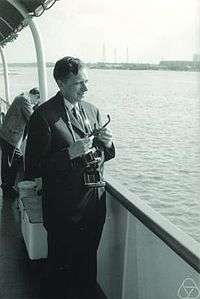Hans Grauert
| Hans Grauert | |
|---|---|
|
Hans Grauert | |
| Born | February 8, 1930 |
| Died | September 4, 2011 (aged 81) |
| Nationality | German |
| Fields | Mathematician |
| Institutions | University of Göttingen |
| Alma mater | University of Münster |
| Doctoral advisor |
Heinrich Behnke Beno Eckmann |
| Doctoral students | Wolf Barth |
| Known for | Grauert–Riemenschneider vanishing theorem |
| Notable awards |
DMV Ehrenmitgliedschaft Cantor medal (2008) |
Hans Grauert (8 February 1930 in Haren, Emsland, Germany – 4 September 2011) was a German mathematician. He is known for major works on several complex variables, complex manifolds[1] and the application of sheaf theory in this area, which influenced later work in algebraic geometry.[2] Together with Reinhold Remmert he established and developed the theory of complex-analytic spaces. He became Professor at the University of Göttingen in 1958, as successor to C. L. Siegel. The lineage of this chair traces back through an eminent line of mathematicians: Weyl, Hilbert, Riemann, and ultimately to Gauss.[3] Until his death, he was professor emeritus at Göttingen.
Grauert was awarded a fellowship of the Leopoldina.[4]
Early life
Grauert attended school at the gymnasium in Meppen before studying for a semester at the University of Mainz in 1949, and then at the University of Münster, where he was awarded his doctorate in 1954.[4]
See also
Publications
- Grauert, Hans (1994), Selected papers. Vol. I, II, Berlin, New York: Springer-Verlag, ISBN 978-3-540-57107-0, MR 1314425
- with Klaus Fritzsche: Several Complex Variables, 1976; hbk[5] softcover reprint 2012.
- with Klaus Fritzsche: From Holomorphic Functions to Complex Manifolds, 2002
References
- ↑ Huckleberry, A (2009). "Hans Grauert: Mathematiker Pur" (PDF). Notices of the American Mathematical Society. 55 (1): 38–41.
- ↑ Bauer, I. C. et al. (2002) Complex geometry: collection of papers dedicated to Hans Grauert, Springer.
- ↑ Grauert, H. (1994) Selected Papers, Springer.
- 1 2 O'Connor, J.J.; Robertson, E.F. (November 2006). "Hans Grauert". MacTutor. Retrieved 2009-12-22.
- ↑ Shiffman, Bernard (1979). "Review: Several complex variables by H. Grauert and K. Fritzsche" (PDF). Bull. Amer. Math. Soc. 1 (3): 563–566. doi:10.1090/s0273-0979-1979-14623-8.
External links
- Hans Grauert at the Mathematics Genealogy Project
- photo of Hans Grauert at Oberwolfach
